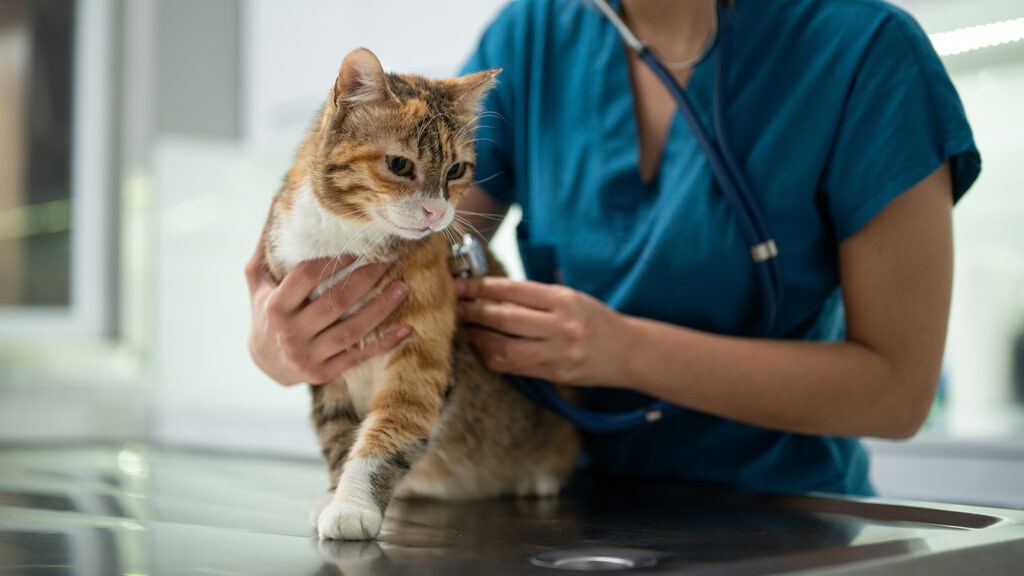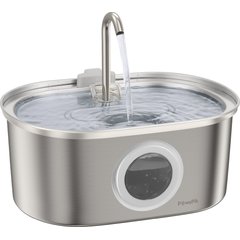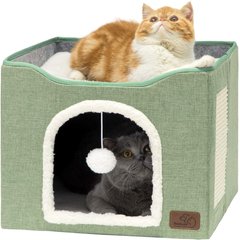What Are Upper Respiratory Infections in Cats?

Photo by ilkermetinkursova/E+ via Getty Images
An upper respiratory infection in cats is similar to a human cold: It can leave your kitty feeling sniffly, stuffy, and not their best. Caused by viruses—and occasionally bacteria—these infections spread easily among cats, especially in multi-cat homes or shelter environments.
We spoke to two veterinarians to understand what causes upper respiratory infections in cats, how to tell if your kitty has one, and how to help them recover.
Key Takeaways
- Upper respiratory infections (URIs) in cats are often caused by viruses like feline herpesvirus-1 and feline calicivirus, and they are highly contagious.
- Common symptoms include sneezing, nasal discharge, watery eyes, coughing, fever, and lethargy.
- Mild cases can often be treated at home with supportive care, but severe or persistent symptoms require veterinary attention.
- Preventive measures include keeping up with vaccinations, reducing stress, and maintaining a clean, cat-friendly environment.
What Is an Upper Respiratory Infection in Cats?
An upper respiratory infection (URI) occurs in the nose, sinuses, mouth, and/or throat. Symptoms, such as sneezing and congestion, happen as the body works to clear out the invading germs.
Most URIs are highly contagious, spreading through direct contact with an infected cat’s saliva, eye and nasal discharge, or contaminated surfaces like food bowls, bedding, or human hands, explains Eliza O’Callaghan, DVM, managing veterinarian for Small Door Vet in New York, New York.
According to Dr. O’Callaghan, certain cats are more susceptible to URIs, including:
- Kittens
- Senior cats
- Those in multi-cat environments, such as shelters, catteries, and boarding facilities
- Brachycephalic breeds, such as Persians, Himalayans, or Exotic Shorthairs (their shorter nasal passages cause reduced mucus clearance)
- Those with chronic illnesses, such as FIV, FeLV, diabetes, or asthma
- Cats experiencing stress, such as moving, traveling, or adjusting to a new pet
Cat Upper Respiratory Symptoms
Upper respiratory infections in cats can cause a range of symptoms, from mild sniffles to more severe issues that require veterinary care.
Common signs include:
- Sneezing
- Watery or goopy eyes
- Redness or swelling around the eyes (conjunctivitis)
- Squinting or eye irritation
- Runny, stuffy, or crusty nose
- Loss of appetite or refusal to eat
- Coughing
- Low energy
- Fever
- Mouth ulcers
- Swollen lymph nodes
- Trouble breathing
According to Dr. O’Callaghan, visit your vet if your cat:
- Stops eating for 24 hours or more
- Has thick nasal or eye discharge
- Has severe congestion
- Is open-mouth breathing
- Has persistent fever
- Is lethargic
- Is coughing
The following cats should be seen at the first sign of illness, because they’re more vulnerable to complications, says Dr. O’Callaghan:
- Kittens
- Senior cats
- Brachycephalic breeds
- Immunocompromised cats
How Do Cats Get Upper Respiratory Infections?
URIs in cats are most commonly caused by feline herpesvirus-1 (FHV-1) and feline calicivirus (FCV).
“Once infected with herpesvirus, a cat becomes a lifelong carrier, with stress triggering flare-ups,” Dr. O’Callaghan explains. “Some cats infected with calicivirus may also remain chronic carriers and shed the virus long-term.”
While certain bacteria, such as feline bordetella, chlamydophila, mycoplasma, and cryptococcus, can cause upper respiratory infections, most of the time, the bacteria are secondary infections that develop after a virus has already triggered the illness, says Mandi Shearhart, DVM, staff veterinarian at Best Friends Animal Society in Fayetteville, Arkansas.
Cat Upper Respiratory Infection Treatment
“Just like with humans that get a cold, supportive care is often the most important treatment for a cat with an upper respiratory infection,” Dr. Shearhart says. This mainly involves reducing stress and ensuring the cat keeps eating and stays hydrated, she says.
Depending on the severity of the case, your vet may also recommend the following treatments for a cat with a URI:
- Antibiotics: If a primary or secondary bacterial infection is suspected, an antibiotic (usually doxycycline) will be prescribed to clear it up.
- Antiviral medications: In cases caused by feline herpesvirus, an antiviral drug called famciclovir may be prescribed to help reduce symptoms.
- Eye drops or ointments: If the infection affects the eyes, medicated drops or ointments can help clear up irritation and discharge.
- Fluids and hospitalization: If a cat becomes severely dehydrated or refuses to eat for more than a day, hospitalization with IV fluids and nutritional support may be necessary.
- Medications: Anti-nausea medication, appetite stimulants, or decongestants may be prescribed to reduce symptoms, Dr. Shearhart says.
- Supplements: Your vet may suggest probiotics (such as Purina Pro Plan FortiFlora or Nutramax Proviable) or amino acid supplements like L-Lysine (found in products like Viralys and Vetri Lysine Plus) to help support your cat’s immune system, says Dr. Shearhart. Another option for immune supplements would be Nutramax Imuquin.
Recommended Products
Home Remedies for Upper Respiratory Infections in Cats
Mild upper respiratory infections in healthy adult cats may clear up on their own within seven to 14 days with supportive care at home, says Dr. O’Callaghan. However, this approach should only be used for mild cases where the cat is still eating, drinking, and showing signs of improvement.
Here are some ways to manage your cat’s URI at home:
- Keep your cat hydrated. Encourage your cat to drink plenty of water by placing fresh, clean water in several spots around your home. A cat water fountain, like the PawsPik SS-01, can be a great way to encourage drinking. Also, if you’re not already feeding wet food, Dr. Shearhart recommends adding it to their diet, as its high-water content supports hydration.
Recommended Product
- Make mealtime more appealing. Cats with a stuffy nose may lose their appetite, because they can’t smell their food. Warming up their wet food slightly or offering strong-smelling options, like Fancy Feast Flaked Tuna Feast, can encourage eating.
Recommended Product
- Use a humidifier or steam therapy. Using a humidifier, like Beurer, or placing your cat in the bathroom and running a hot shower for 10–15 minutes can help with congestion, Dr. Shearhart says.
Recommended Product
- Gently clean their nose and eyes. Use a warm, damp cloth to wipe away any nasal or eye discharge. This helps prevent irritation and keeps your cat more comfortable.
- Reduce stress. Because stress can weaken the immune system and worsen symptoms, keep your cat’s environment as calm and quiet as possible, Dr. Shearhart advises. Provide a cozy bed, like the Best Friends by Sheri Donut Cuddler, and avoid loud noises or major changes in routine.
Recommended Product
How To Prevent Upper Respiratory Infection in Cats
While cat respiratory infections can’t always be avoided, there are steps you can take to reduce your cat’s risk. These include:
- Stay up to date on vaccinations. The FVRCP vaccine helps protect against feline herpesvirus and calicivirus—the two most common causes of upper respiratory infections in cats.
- Minimize stress. Provide a calm environment; plenty of hiding spots, like the Bedsure Cat Cave; and a consistent routine to help keep your cat stress-free.
Recommended Product
- Keep their living space clean. If you have multiple cats, disinfect shared spaces and items often.
- Avoid exposure to sick cats. If you’re adopting a new cat, make sure they’re healthy and up to date on vaccinations before introducing them to your resident pets. If you volunteer at a shelter or interact with stray cats, wash your hands and change clothes before handling your own pet.
- Support a strong immune system. Good nutrition, fresh water, a safe environment, and regular vet checkups can help keep your cat’s immune system strong.
Upper respiratory infections in cats are common, but with the right care, most cats bounce back quickly. Keep an eye out for symptoms, and don’t hesitate to call your vet if your cat stops eating or seems to be struggling. Staying on top of vaccinations, reducing stress, and creating a calm, cozy space can go a long way in keeping your cat healthy—and breathing easy.
FAQs About Cat URIs
Q: Can feline upper respiratory infection be fatal?
A: In most cases, upper respiratory infections in cats will be limited to sneezing, coughing, and eye discharge that can resolve with either at-home supportive care or, in more severe or chronic cases, with medications and vet care in the clinic.
In rare cases, upper respiratory infections in cats can be fatal for very young, very old, or immunocompromised cats, especially when they become depressed, stop eating for longer than 24 hours, or develop severe breathing issues.
This is why prompt veterinary attention when a sick cat is not eating, coughing a lot, or feverish is important—so that treatment can be started as soon as possible and improve the chances of recovery.
Q: What is chronic URI in cats?
A: Chronic URI occurs when a cat has been sick with a virus for a few weeks with accompanying inflammation in the nose and upper throat. This can not only lead to long-term damage to the delicate lining of the nose and upper throat but also changes in the function of the upper airways—predisposing cats to recurring bacterial infections throughout their lives.
Q: What does a cat with a respiratory infection sound like?
A: A cat respiratory infection can cause sneezing, congestion, and fever. It can leave your kitty sounding congested, with sniffling, wheezing, or light coughing. Some may develop a raspy or hoarse meow due to throat irritation.
Q: Is a cat’s URI contagious to humans or other pets?
A: URIs in cats don’t spread to humans but are highly contagious among cats.
While rare, some bacterial infections, like Bordetella, may pose a risk to other pets like dogs, so it’s best to keep sick cats isolated until they recover.
Q: Can a cat’s URI go away on its own?
A: Mild URIs in cats usually clear in seven to 14 days with proper at-home care. However, Dr. Shearhart advises seeing a vet if symptoms worsen or persist beyond two weeks, or if your cat stops eating for more than 24 hours.
Q: What is the best antibiotic for feline upper respiratory infection?
A: Doxycycline is typically the go-to antibiotic for bacterial upper respiratory infections or secondary bacterial infections in cats.
In some cases, amoxicillin may be used as an alternative for certain bacterial strains.












